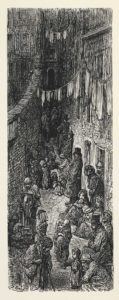Poverty in “A Christmas Carol”
Blog Post 5: Poverty in “A Christmas Carol”
In the time of Charles Dickens there was a large gap between those who could afford to live and those who could not. The poor of Victorian England had a hard life, especially after the passing of the Poor Law Amendment Act 1834. This demolished the old ways of poor relief that was run through the churches and created a system that sent the poor to workhouses where many of the poor died of starvation, disease or simply being overworked. A particular depiction of poverty that sticks out in Dickens’ writings is “A Christmas Carol.” In this short story an old miser is visited by three ghosts on Christmas eve and warned to change his behavior or this Christmas will be his last.
One particular instance of poverty creeping into the cushy life of Ebenezer Scrooge is whenever he is visited by the Ghost of Christmas Past. The ghost takes him back to his childhood and how he was a poorer soul at one point:
“This is the even-handed dealing of the world!” he said. “There is nothing on which it is so hard as poverty; and there is nothing it professes to condemn with such severity as the pursuit of wealth!” “You fear the world too much,” she answered, gently. “All your other hopes have merged into the hope of being beyond the chance of its sordid reproach. I have seen your nobler aspirations fall off one by one, until the master-passion, Gain, engrosses you. Have I not?” “What then?” he retorted. “Even if I have grown so much wiser, what then? I am not changed towards you.” (Dickens 40)
Here the ghost is telling Scrooge that his life has turned out the way it has simply because he feared the life of the poor. The poor had a very harsh life in his time and many of them died young. The lavish, but isolated, life that Scrooge has is because he’s afraid that he’s going to lose everything that he’s earned. Dickens has making a commentary about the workhouses and the state of the poor. He made his main character so terrified of falling into that kind of life that he pushed away all of his loved ones and lives an isolated life with his riches. A life of poverty was so terrifying to him as a child that he shut himself off from the world and decided then and there that the only person he needed to worry about was himself. This may also be a commentary on the upper-class of the time as well and their unwillingness to help the poor of the country.

